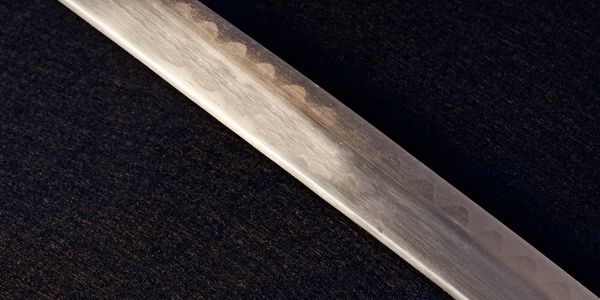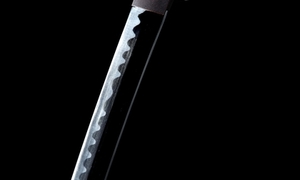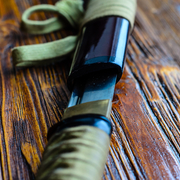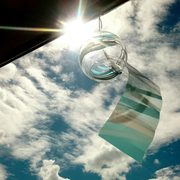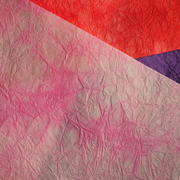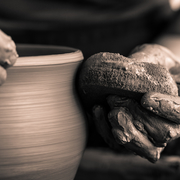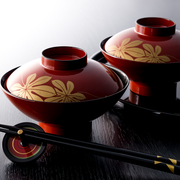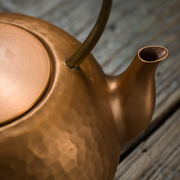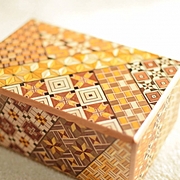Let’s walk through disciplined sword polishing.
A swordsmith can do simple polishing, but proper polishing is normally handled by Togi-shi (sword polisher).
Sword polisher works for “improving cutting quality”.
On the other hand, Togi-shi pursues the sheer beauty of each sword by making the most of its genuine characteristics.
It means that a sword made with a swordsmith’s full devotion, does not appear as a beautiful Japanese sword we know, when it comes to Togi-shi.
it has no clear shape of its cross section, no distinction between the surface color of black and the blade edge color of white, which a swordsmith created, and no Hamon (temper line) nor luster.
Togi-shi shapes a clear cross section of a blade and polishes each part; Ji (surface), Ha (edge), Mune (back), Kissaki (point).
By polishing, the surface color of black and the blade edge color of white become clear.
It also brings luster to emerge its bare surface (iron patter) and Hamon (temper line) beautifully, which attracts people.
Togi-shi, thus, enriches its beauty to an art craftwork by highlighting its colors and patterns such as Hamon, created by a swordsmith.
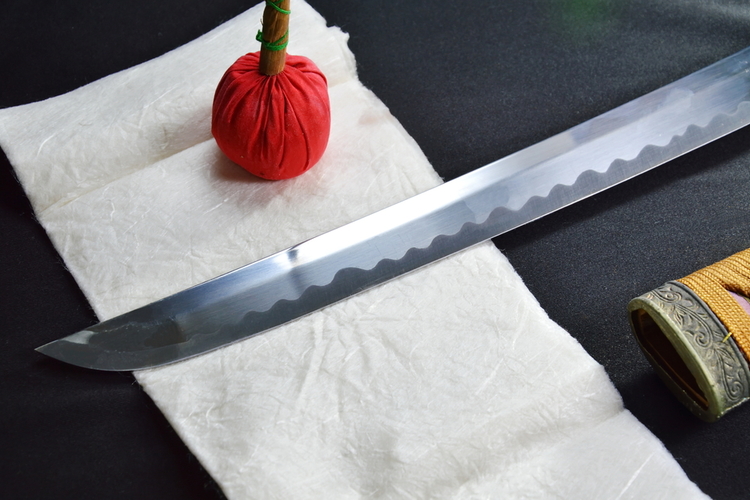
Because of its characteristics, as for a Japanese sword, the whole blade is polished besides Nakago (tang), unlike other types of swords, for which the only edge is polished.
Nowadays, a Japanese sword is appreciated as an art craftwork and cultural assets, Togi-shi plays the essential role to produce a beautiful and strong Japanese sword to present it to the world.
Main Jobs of Togi-shi and Process
Polishing of a Japanese sword is fine and delicate job all manually done under several processes by using different types of whetstones with different degree of roughness.
The process of polishing is mainly divided into Shitaji Togi (foundation polishing) and Shiage Togi (finish polishing).
Shitaji Togi (foundation polishing) is to reshape a blade to remove unevenness by changing several types of whetstones on its grade of roughness from big to small, to refine the surface of a blade and shape the whole shape of a blade.
Shiage Togi (finish polishing) is like make-up for a Japanese sword.
It emphasizes the characteristics enriched by Shitaji Togi more to finish a Japanese sword to get appreciated.
Shitaji Togi (Foundation Polishing)
Shitaji Togi uses 5 types of whetstones from the roughest one.
The tools for Shitaji Togi include a Shogi (a stool), a Fumaegi (a wooden bar to hold), a Todai (a stand for a whetstone), a Togioke (a polishing bucket), Uchiko (powder made from grinding whetstone finely) besides several types of whetstones.
On Shitaji Togi, the posture is important when you put a blade on a square whetstone.
You sit on a Shogi facing your body straight to a whetstone and hold Fumaegi by stepping on it to fix a whetstone obliquely.
Then, raising right knee under right arm, you polish putting your weight by half-rising.
Holding a blade by your right hand with your left hand lightly on it, you polish it by putting it on the surface of a whetstone moving your arms up and down, right to left.
Polishing uses not only arms but also the whole body like a pendulum.
B insuido Whetstone
This process is to remove the rust to shape the whole form of a Japanese sword and create an edge.
Polishing Mune (back), Shinogi (blade ridge), Ji (surface) and Kissaki (point) shapes the basic form of a Japanese sword, which is a very essential process.
You press a blade on the surface of a whetstone to pull it then push it with stress.
There are two ways of putting a blade on the surface of a whetstone; “Suji Chigai” referring to “obliquely” and “Kiri” referring to “vertically”.
For Mune and Shinogi, Suji Chigai is used and for Ji and Kissaki, Kiri is used.
When a blade has too much rust, the rougher whetstone, Kongodo, is used before this Binsuido.
K aiseinagurado Whetstone
This process is to remove the trace of a whetstone little by little.
Here, remove the trace of Binsuido polishing.
N akanagurado / Chunagurado Whetstone
Removing the previous polishing traces, polish a blade in a vertical direction after Suji Chigai (obliquely) polishing, which is referred as “Tatsu o Tsuku”.
Also, in order to increase the effect of a whetstone, “Shakuri Togi”, referring to the way of polishing by flipping a blade.
K omanagurado Whetstone
Polish with the fine surface of Nagurado vertically to remove all traces of whetstones.
U chigumorido Whetstone (Hato and Jito)
This is the last process of Shitaji Togi (foundation polishing); polishing an edge and a surface.
Hato whetstone is soft to make Hamon (temp line) white.
Jito whetstone is harder than Hato to emphasize a bare surface.
The way of polishing, which is laying stress on pulling, is a characteristic.
The way of pulling differentiate the exposure of a bare surface, which requires extreme care.
This process shows how Hamon and a bare surface (iron pattern) work.
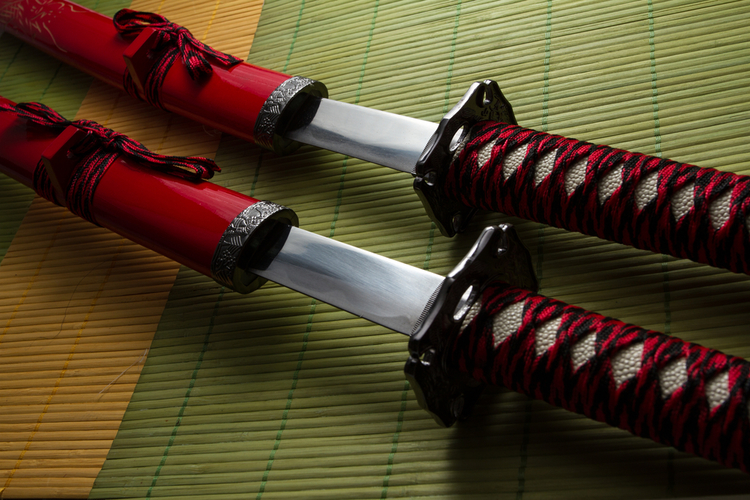
Shiage Togi (Finish Polishing)
This is the process to finish a blade finely by enriching the beauty of a bare iron presented by Shitaji Togi, and adjusting the color tone.
From this point, thin small piece of whetstones is used by fingers.
H azuya (Edge Polish Stone)
Remove the trace of Uchigumorido whetstone to enrich the beauty of an edge surface by polishing Hamon.
It uses Hazuyado, which is a thin small piece of Uchigumorido backed with Yoshino paper and lacquer.
Putting it along with a tempered edge of a blade to polish.
J izuya (Surface Polish Stone)
Put a thin small piece of Narutakido, which has a fine surface, on a blade and polish a surface to show a bare surface of an iron with thumb.
Sufficient Jizuya makes the next process “Nugui” work better.
N ugui (Wiping)
Put Kanahada (a very fine whetstone powder) mixed with clove oil on a blade and wipe it with Oume-wata cotton ball.
It brings a bare iron with blue-black color and the luster.
On this process, almost all traces of whetstones are gone.
H adori
After Nugui, the color of Yakiba (a tempered edge) gets black, so Hadori with Hazuyado finishes a blade with a beautiful white edge.
By this process, the contrast of a black surface and a white edge stands out.
On this, it is polished along with the shape of Hamon.
This requires Togi-shi’s sensitivity and creativity to represent the original Hamon on tempering.
M igaki (Polishing)
Polish Mune and Sinogiji with a steel polishing needle to get unique and black luster to it.
At end of Migaki, Nagashi, which refers to the signature of Togi-shi, is put on Habaki (a piece of metal encircling the base of a blade).
(Nagashi is sometimes done at the very end.)
N arume
Prepare for a Narume board with Hazumedo and polish with the same posture as Shitaji Togi.
Finish Yokote-suji (side line), meaning shaping straight the boshi (the pattern of Hamon in the tip area), and polish the tip of Kissaki (point) to white.
All of the above are the processes of Togi-shi, which takes 10-15 days.
Any process cannot be missed to complete good polishing.
How it shows its beauty and utility, which a swordsmith created, and develops to an art craftwork depends on Togi-shi’s concentration to complete fine and delicate processes, techniques and aesthetic sensitivity.
The late Kokan Nagayama, a living national treasure Togi-shi, introduced his teacher’s words about Shiage Togi as follows.
“The state that “a bare iron has blue-ish dampness, an edge is as white as a skin with fine snow, Hachu (patterns of an edge) is bright, Shinogiji is basically black, Jiha is well balanced” represents good polishing,” my teacher said. (“Techniques, eyes and heart of Togi-shi, polishing a Japanese sword” written by Kokan Nagayama)
Not to mention, realizing this requires fine and high-level techniques.
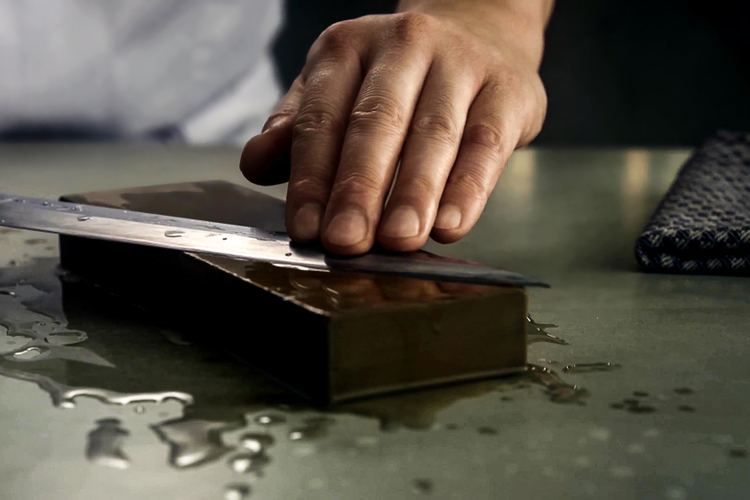
Natural and Artificial Whetstones
There are natural and artificial whetstones.
Since the number of natural whetstones with high quality has declined and the quality of cheap artificial ones has improved, artificial ones are used more often.
Although artificial whetstones are used for a Japanese sword, fine-surfaced Uchigumorido and Shiage Togi rely on natural whetstones.
Modern Togi-shi
Currently, there are about 50 professional Togi-shi for a Japanese sword.
There is no qualification system, nor special schools, so Togi-shi learns from masters or polishing classes to improve own skills.
Winning at national competitions of a sword professions leads to some achievements.
Sword polishing preserves the culture of a Japanese sword to future generations by reviving the beauty of old Japanese swords with polishing, not only new ones.
If you would like to know the details of producing a Japanese sword, please check the following article.

